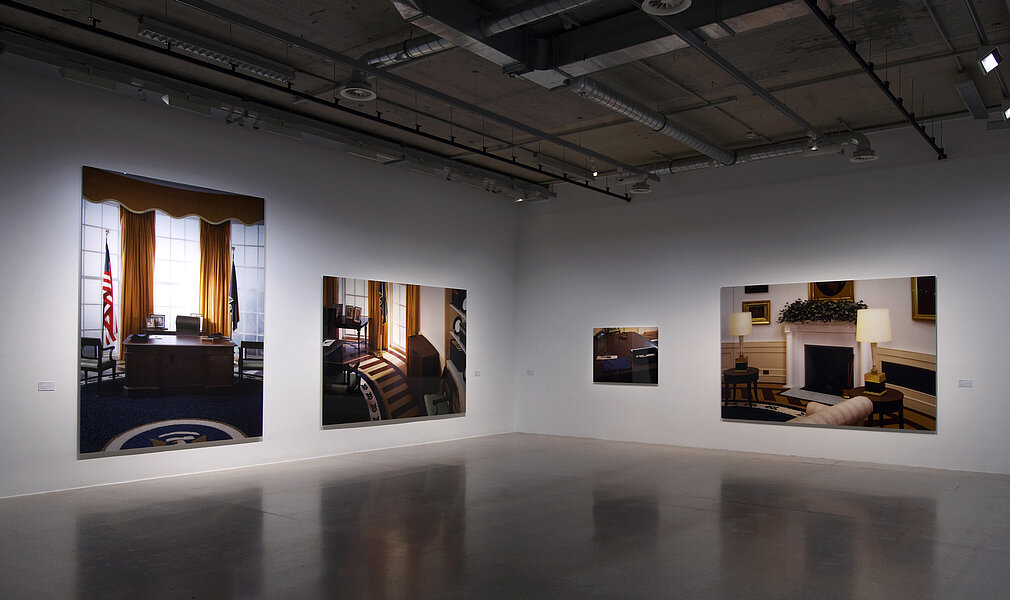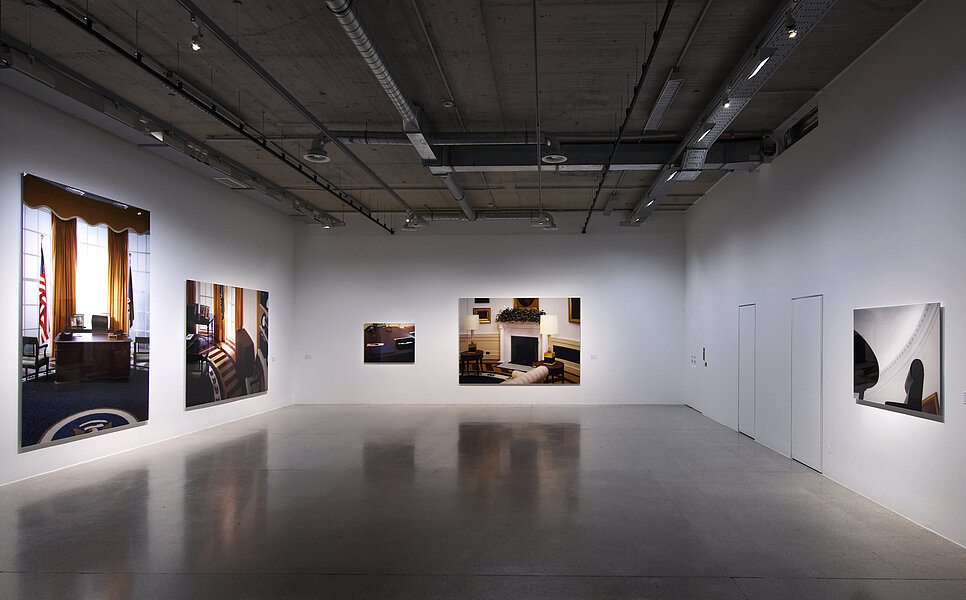
Demand, Thomas
Presidency
2008
| Object description | 5 Color Photographs in Diasec |
|---|---|
| Dimensions |
Objekt:
height: 92 cm,
width: 140 cm,
depth: 3 cm,
height: 210 cm,
width: 300 cm,
depth: 3 cm,
height: 200 cm,
width: 289 cm,
depth: 3 cm,
height: 92 cm,
width: 122 cm,
depth: 3 cm,
height: 310 cm,
width: 223 cm,
depth: 3 cm
|
| Year of acquisition | 2009 |
| Inventory number | ÖL-Stg 429/0 |
| Creditline | mumok - Museum moderner Kunst Stiftung Ludwig Wien, Leihgabe der Österreichischen Ludwig-Stiftung |
| Rights reference | Bildrecht, Wien |
| Further information about the person | Demand, Thomas [GND] |
| Literature | Hyper Real |
These photographs by Thomas Demand offer a view of an office. At first blush, there is nothing unusual about the picture. And yet the room we see seems to be under some mysterious spell: not only are there no people to be seen, but all traces of everyday life have been eliminated. When you get closer to the picture, directing the focus on this or that detail, you will soon notice that there is in fact something wrong about the surfaces of the objects and pieces of furniture. There is a simple explanation for this: everything in the picture is made of paper and cardboard. What we see is the photograph of a three-dimensional life-sized model, created in meticulous detail from newspaper photographs. Thomas Demand constructs these models in his studio, then takes pictures of them and finally destroys them. Demand is mainly interested in places that are associated with socially or politically relevant events. In the finished pictures, however, these events have been blotted out completely. What remains are strangely depleted phantom images informed by a sterile artificiality that bears not the slightest trace of what had once been the occasion for intense press coverage. For “Presidency”, Demand reconstructed the US president’s White House office as a prototypical site of power. The series was originally commissioned by the New York Times magazine in November 2008, shortly after the presidential elections were held. Demand’s pictures were thus themselves fed back into the very news-cycle from which they originated. Demand’s photographs are pictures about pictures – pictures that have been disseminated by the media and that live on in our minds as vague memories.Die großformatigen Fotoarbeiten von Thomas Demand zeigen den Blick in ein Büro, soweit ist nichts ungewöhnlich. Aber über dem Raum liegt eine rätselhafte Starre: Menschen fehlen, und alle Spuren des täglichen Lebens sind getilgt. Aber sobald man näher hintritt Details genauer betrachtet bemerkt man, dass mit den Oberflächen all der Objekte und Einrichtungsgegenstände etwas nicht stimmt. Alles was wir sehen ist aus Papier und Pappe gebaut. Eine Attrappe, detailgenau und manchmal sogar lebensgroß nach fotografischen Vorlagen aus Zeitungen. Thomas Demand baut sie in seinem Studio, fotografiert sie und zerstört sie dann wieder. Es sind Schauplätze, die mit gesellschaftlich oder politisch brisanten Ereignissen verknüpft sind. Genau diese allerdings sind aus den Bildern gelöscht: Zurück bleiben entleerte „Phantombilder“ von steriler Künstlichkeit ohne Spuren dessen, was einmal Anlass für eine Berichterstattung war. Für „Presidency“ hat Demand das Büro des US-Präsidenten im Weißen Haus als einen prominenten „Schauplatz“ der Macht rekonstruiert. Der eigentliche Anlass für die Serie war ein Auftrag des New York Times Magazine im November 2008, kurz nach der Präsidentschaftswahl in den USA. Demands Bilder nach Vorlagen aus Magazinen wurden nun wiederum selbst als „Nachrichtenbilder“ verwendet. Dabei wiederholen sie das in der medialen Berichterstattung immer wieder inszenierte Bild des Oval Office und seiner Ausstattung, die das politische Selbstverständnis der jeweiligen Machthaber repräsentiert. Demands Fotografien sind Bilder, die von Bildern handeln: solchen, die in den Medien verbreitet werden und die als diffuse Erinnerungen in unserem Gedächtnis weiterleben.
© mumok – museum moderner kunst stiftung ludwig wien


